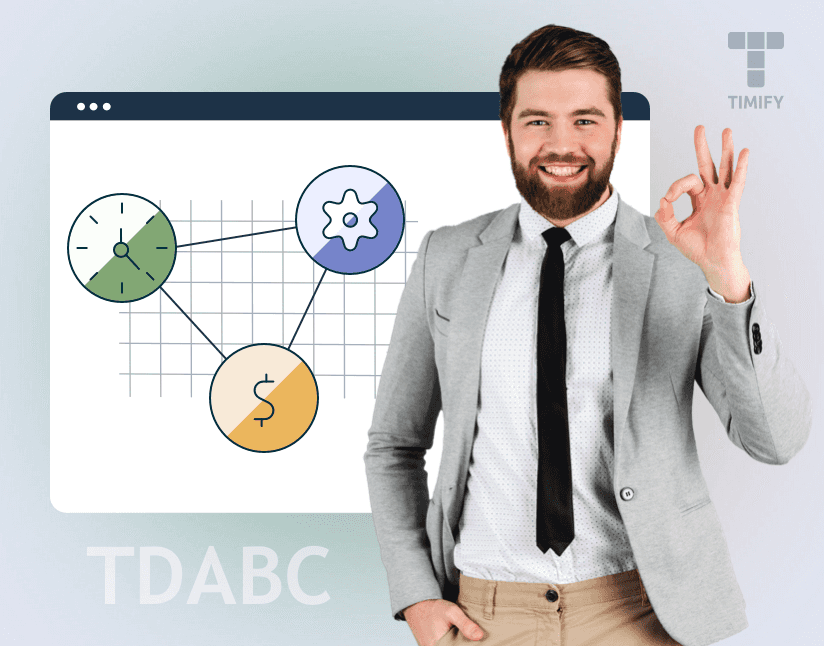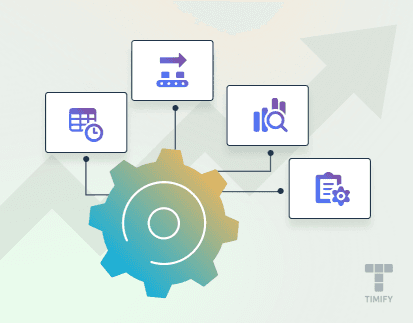
Understanding the cost of business processes can be tricky, even when you break them down into individual tasks. If you don’t know how long each task takes, you won’t know its true cost and won’t be able to allocate the right resources.
This is where time-driven activity-based costing comes in. But what exactly is it, and how does it benefit your organization? In this post, we’ll give you a brief introduction to the concept and a step-by-step guide.
Understanding the foundations of TDABC
Time-driven activity-based costing (TDABC) is a cost-management strategy that gives organizations a better understanding of their costs by focusing on the time required to carry out specific activities and processes.
TDABC simplifies the costing process because it’s based on just two parameters: the capacity cost for each resource and the time required to perform a specific activity. It involves identifying the steps that make up operational processes, recording the time taken for each step, and assigning a corresponding cost.
The practice was first introduced in 2004 and published in the Harvard Business Review, based on an earlier methodology called activity-based costing (ABC). So, what is the difference between TDABC and ABC, and why is time-driven activity-based costing important?
Traditional ABC assigns costs based on direct labor hours or machine hours. Bringing the “time” factor into the equation gives you a clearer picture of the costs, enabling you to allocate resources where they’re most needed (or make cost savings by reducing unused capacity).
Another key difference is that ABC uses employee surveys and manual time logs to track activities and costs, which is time-consuming and expensive. TDABC uses real-time data to produce informed estimates and direct observation. It’s a more flexible approach, allowing you to adapt your cost analysis approach as the business evolves.

A guide to time-driven activity-based costing
TDABC is designed to streamline your cost-management activities, so here’s a simple step-by-step guide to the methodology.
1. Recognize tasks and resource groups
Define activities within the business process
The first step is to identify the processes your organization uses to produce a product or service. Then, think about the sequence of individual activities within the overall process, each using time and resources. Make a list of all these sub-processes or tasks. It’s a good idea to represent them visually by creating a detailed process map.
For example, TDABC is often used in healthcare to create an improved cost measurement system. In this case, all the key processes performed across the entire care cycle are listed and mapped out across all of the providers involved.
Group the activities into their relevant resource pools
The resources for each subprocess must be drawn from the relevant resource or cost pools. For instance, an organization might have one resource pool for customer service activities and another for order processing. Grouping tells you how many activities will draw from each pool.
TOP TIP: Remember that you’ll need to account for any shared resources, such as equipment or personnel covering multiple tasks or processes. Split the cost of a shared resource between activities, or assign costs proportionally.
Identify the primary cost drivers for each activity
A cost driver is any factor that triggers an expense or a change in the cost of producing products and services. For example, the number of hours your employees work drives the cost of your wage bill.
There are two types of cost drivers: resource cost drivers (measured by consumption of resources) and activity cost drivers (specific activities and their frequency). These are further divided into direct costs (materials and labor) and indirect costs (such as office supplies and insurance).
In time-driven ABC models, cost drivers are influenced by customer behaviors and task complexity. Complex activities consume more time and resources, as do unique or customized services requested by customers.

2. Determine capacity cost rates
The capacity cost rate measures how much it costs per unit of time to supply resources to your activities. It’s calculated using the cost of the resources required and the practical availability of those resources. In TDABC, you’ll do this for both human and non-human resources.
Capacity cost rate = Total cost of resources / Total capacity available (expressed as a unit of time)
To measure personnel capacity, identify the number of days per year when an employee is available to work and the number of available minutes per day. Multiply the minutes by the days to get the total number of available minutes per year.
Now, add up the employee’s salary, benefits, and overhead costs to calculate the total cost per minute for employing this person. To get the capacity cost rate, divide this total cost by the total number of minutes the person can work in a year.
TOP TIP: It’s important to estimate the practical capacity of workers’ time rather than theoretical (theoretically, they’re available 100% of each working day, but practically they’ll take breaks, vacations, and sick days). With software for time and expense management, you can automate the process and reduce manual labor to get an accurate picture of their actual hours.
The capacity cost rate is useful because it highlights the opportunity cost of excess capacity (such as overstaffing). Take the total spend of the relevant department, and subtract the total capacity cost. Divide the result by the capacity cost per time unit to find the cost of unused capacity.
3. Gauge time equations
Collect information on the time needed for each identified task
The next step is to determine the amount of time required to complete each task. Accuracy is crucial to understanding the cost impact of each activity, so use real-time data from time-tracking and resource-management tools alongside managerial estimates to get the most complete understanding possible.
To calculate the total time spent on the activity, multiply the time per task by how often the task occurs. If it takes 10 minutes to capture new customer details, and you do this 50 times per day, that’s a total of 500 minutes for that task.

Develop time equations for different resource pool
It’s important to keep track of which resource pools you’re using for which activities. Because each resource has a different cost, you’ll need to run a different time equation for each pool—using the capacity cost figures from the previous step.
The total cost of a product or service is determined by multiplying the total procedure time by the per-hour cost of the resources. So, if the time required for a certain task is 1.5 hours, and the capacity cost of the relevant resource is $40 per hour, the cost per task is $60.
If the team will repeat this task 6,000 times during the given period, its actual cost is $360,000. Once you’ve done this equation for each task in the overall process, you’ll know the total process cost.
Refine time equations based on observations
As well as using estimates and real-time data, you’ll need to observe the activities and adjust your time equations accordingly to give accurate costs. For example, the time required to complete tasks will vary depending on levels of complexity and different customer demands.
4. Distribute costs to targets
Now that you know the time required and the cost for each individual task, you can allocate resources to specific targets (products, services, and customers) based on these figures.
Let’s say your company offers two types of handmade products. Product X has a lot of individual components and requires many labor hours to produce. Product Y has a single component and can be produced in much less time. So, you can allocate more costs to Product X because it takes up more resources.
It’s a good idea to build these cost allocations into your cash flow forecasts using software for cash flow management. This way, you can create an accurate budget forecast and plan your resources and targets accordingly. In doing so, you’ll find it easier to monitor a team or individual’s progression and be able to identify any potential discrepancies early.

5. Validate and enhance your TDABC model
Test for model accuracy
Once you’ve created a TDABC model, you need to check that it’s giving you an accurate picture of costs. Test the model on various scenarios, and compare the results to your actual resource consumption and capacity costs for a given period. If they don’t match, your model isn’t working correctly.
Incorporate feedback and make adjustments
The big advantage of TDABC is that it’s dynamic and flexible, so you can easily adjust costing models when needed. Apart from checking accuracy, you should take feedback from employees, managers, and accountants. Does each department have the resources to complete its tasks?
Continuously refine and improve
You’ll need an update whenever you change the way you carry out business processes, or when the cost of resources (such as equipment or wages) changes. Evolving customer behavior can also be a reason for adjusting the model, so check your CRM for insights.
6. Integrate TDABC into Your Company
Communicate with stakeholders
For your company to fully embrace TDABC, you’ll need to communicate its benefits to your stakeholders. Before the implementation process, send out information on how the strategy will improve operational efficiency in your organization. This will help you to overcome any resistance to change.
TOP TIP: Keep the lines of communication open. Once you’ve been using TDABC for a while, ask for feedback to make sure everyone is happy with the system, and encourage them to ask questions or make suggestions.
Provide employees with the necessary training
Again, you’ll need buy-in from the workforce, so make sure everyone is aware of the new process and how it works. Provide training sessions on the concept and benefits and demonstrate how TDABC works with real examples. Include training on how to gather the right data from your existing systems, from time-tracking software to accounting platforms and CRMs.
Leverage TDABC into the decision-making processes
TDABC enables you to make more informed decisions because you have a clearer understanding of how business tasks affect your finances. For example, you can adjust resource allocation to optimize costs, and identify under-utilized capacity and other inefficiencies.

Final thoughts
Time-driven activity-based costing is an ideal way to optimize efficiency and costs for your organization. With only two parameters to measure, the methodology simplifies cost management and makes it less labor-intensive by using real-time data instead of manual time logs.
When you focus on time as the main cost driver, you can allocate resources more accurately and avoid under-utilization. It’s easy to adjust the flexible TDABC model when you make changes to processes or to account for variations in customer behavior.
Related articles



